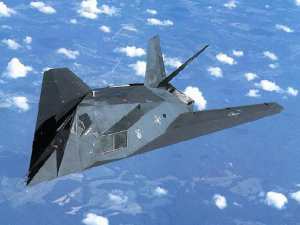
Launched in the 1980's, the Sea Shadow program appears to be the US Navy's first attempt at a stealthy surface vessel, as well as a demonstration bed for computerized sea keeping and reduced manning.
The Sea Shadow has no function beyond demonstrating these concepts. She carries no weapons, no payload, and with a top speed of 14 knots, has surely never delivered commandos to any hostile shore.
Anyone who has seen the F-117 Stealth Fighter will recognize the radar evading family resemblance to the Sea Shadow- indeed, both are Lockheed products.

The most important feature may the flat angled surfaces... rounded and complex surfaces, as found all over your typical vessel, will always present a face somewhere that can reflect a radar wave right back to it's sender, revealing the vessel to prying eyes. Having a minimum number of flat facets, hopefully angled away from the expected threat location, minimizes the chance of radar waves reflecting back. It's not clear if radar absorbing materials are used on the Sea Shadow, but I've read that engine exhaust is directed down between the legs, mixing with the air there before coming out in the open, thus presenting a diluted thermal signature.
Form follows function: The 45° sides mandate a wide stance, so a catamaran is the obvious choice. But why not try out the SWATH (Small Waterline Area Twin Hull) concept while we're at it, and get a nice fat contract for developing the requisite control technology? There's really no other reason for it- SWATH is not stealth, and stealth doesn't need SWATH. You'll notice that SWATH is hardly being embraced by the 21st century Navy- SWATH's main advantage is stable sea keeping, a feature more valued by passenger ferries.
How does this boat work?
See the "About SWATH" section for more detail on this type of hull.

The Sea Shadow rides on two torpedo-like submerged hulls, and is powered by
a diesel-electric drive (diesel-generator in the cabin, drive motors in the
hulls).
Specs:
Overall length: 164 feet
Beam: 68 feet
Draft: 15 feet
Light displacement: 499 tons
Deadweight (carrying capacity): 64 tons
Loaded displacement: 563 tons
Max speed: 14 knots
Despite the looks, this is no speed boat! This may be due to unoptimized
design- perhaps the displacement just couldn't support a more powerful drive.
Certainly, passenger ferry SWATHs have been built that double this speed.

The Sea Shadow was revealed to the public in 1993, and was subsequently laid
up in 1995. It was reactivated in 1999 to help develop concepts for the DDX
program, and is managed by Lockheed's ATL group.
See the following sites for other write-ups on the Sea Shadow:
USN
Fact File
Naval
Vessel Register
FAS
(Federation of American Scientists)
Lockheed
ATL
Not seeing this page in frames?
Get my frames back!